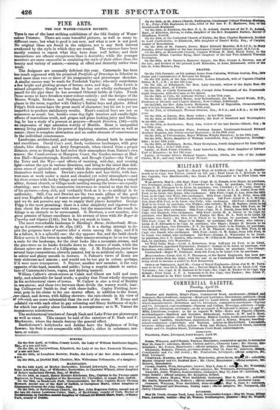FINE ARTS.
THE OLD WATER-COLOUR SOCIETY.
Thu is one of the least striking exhibitions of the Old Society of Water- colour Painters. There are some beautiful pictures, as well as many in- different ones; but what is good is not new, and what is new is not good. No original ideas are found in the subjects, nor is any fresh interest awakened by the style in which they are treated. The veterans have been Mostly content to repeat what they have done well before; and their mannerisms are oftener conspicuous than is desirable; while the younger members are more successful in emulating the style of their elders than the beauty and variety of nature,-aiming at effect and dexterity rather than truth.
The designers are unusually deficient this year. Cattermole has been too much engrossed with his promised Portfolio of Drawings in lithotint to send more than two or three of his imaginative and picturesque sketches.
similar excuse may be made for Frederick Tayler; who only contributes & few bright and glowing groups of horses, cows, and dogs. John Lewis is missed altogether; though we hear that he has not wholly exchanged the pencil for the pipe since he has assumed Oriental habits at Cairo. Frank Stone seems to have forsaken water-colour entirely; and the designs of the Messrs. Wright, Richter, and Stephanoff, occupy the most conspicuous places in the room, together with Oakley's Italian boys and gipsies. Alfred Fripp's Irish scenes have the great merit of character; but his art is yet too imperfect to produce satisfactory results. Hunt's comical boys are not so numerous as usual: but, besides some day-light interiors and candle-light effects of marvellous truth, and grapes and pines looking juicy and bloom- ing, he has a study of a peasant at prayers-Romish Devotion, (10)-with an expression of rapt adoration worthy of Murillo. Hunt is unequalled among living painters for the power of depicting emotion, serious as well as comic: there is complete abstraction and an entire absence of consciousness in the individual countenance.
-- Landscape, architectural, and marine subjects, abound both in number and excellence. David Cox's cool, fresh, verdurous landscapes, with grey clouds, blue distance, and dewy foregrounds, when viewed from a proper distance, seem as though he had stolen their atmosphere from Nature's own source: the Canal-avenue at Hampton Court, the Garden-terrace at Had- don Hall-Knaresborongh, Kenilworth, and Brough Castles-the Vale of the Towy and the Wye-and effects of morning, mid-day, and evening light-arrest the eye in various directions, and bring to the mind that deli- cious sense of quietude and serenity which the contemplation of the scenes themselves would induce. Dewint's corn-fields and hay-fields, with har- vest-men at work under a moist and clouded yet sultry atmosphere-and his river-scenes with bosky foliage and empurpled ground, showing a ruined abbey, distant church, or village-roofs nestling among the trees-are equally charming; save when his mannerism intervenes to remind us that the tone of his pictures-deep, rich,' and Verdantly fresh as it is-is artificial in its uniformity. Still, Cox and Dewint are the two main pillars of the good and true English school-of water-colour painting, as applied to landscape; and we do not perceive any one to supply their places hereafter. George Frpp is the most promising: there is a sober simplicity and vigorous free- dom about his river-scenes with trees; but the mannerism of his touch in foliage is an obstacle to be surmounted. G. Harrison, a new member, also gives promise of future excellence in his avenue of trees with Sir Roger de Coverley and Gipsies (119); but he has yet much to learn.
The most remarkable landscape is Harding's Berne Switzerland; Morn- ing as it sometimes wakes its the Alps, (26). It is a daring attempt to de- pict the gorgeous hues of sunrise after a storm among the Alps; and if it be a failure, it is a splendid one: the sky appears flat, and the lurid clouds flicker across it like veins in marble; their masses seeming to be on too large a scale for the landscape, for the river looks like a mountain-stream, and the pine-trees on its banks dwindle down to the stature of reeds, while the distant spires are those of a Lilliputian city. J. M. Richardson junior has several large compositions, cleverly painted, but in an artificial style • opaque in colour sad glassy smooth in texture. S. Palmer's views of Rome are very elaborate and minute ; and would not be too gay in colour, perhaps, if it were more transparent. S. Rayner, another new member, is the very opposite of the hard, smooth, and petite; being a copyist almost to carica- ture of Cattermole's loose, vague, and dashing manner.
William Callow's street-scenes at Calais and Ghent are bold and mas- terly, and admirable for local truth; a quality that Front wholly disregards in his architectural views of towns. W. Callow is also a rival of Bentley in sea-pieces; and these two between them divide the watery world; leav- ing Collingwood Smith to 'deal with sheer-hulks. Copley Fielding, how- ever, puts in his claim to his one stormy effect, in addition to the forest, mac :land, and downs, with falling showers: the rain-clouds in his view of of robt.wich are more substantial than the rest of the scene. W. Evans and .o.tsfield vie with each other in gay colouring and flimsy feebleness of style: for which last quality alone Gastineau is conspicuous; as is W. Turner for monotonous minuteness.
The architectural interiors of Joseph Nash and. Lake Price are picturesque as well as exact. This cannot be said of the exteriors of F. Nash and F. Mackenzie; where the details destroy the general effect.
Bartholomew's hollyhocks and dahlias have the brightness of living flowers: his fruit is not comparable with Hunt's, either in substance, tex- ture, or colour.


























 Previous page
Previous page